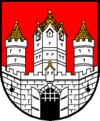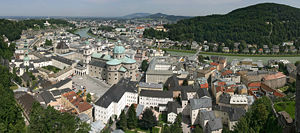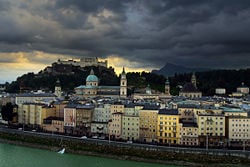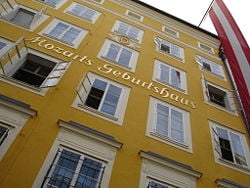Salzburg
- This page is for the city of Salzburg. For the surrounding state of Salzburg, see Salzburg (state). Salzburg is also the German exonym of the Romanian town of Ocna Sibiului. Also not to be confused with the French city of Strasbourg.
| Salzburg | |
|---|---|

|

|
|
| |
| Country | Austria |
| State | Salzburg |
| Administrative region | Statutory city |
| Population | 150,269 (01.01.2007 [1]) |
| Area | 65.678 km² |
| Population density | 2,288 /km² |
| Elevation | 424 m |
| Coordinates | Coordinates: |
| Postal code | 5020 |
| Area code | 0662 |
| Licence plate code | S |
| Mayor | Heinz Schaden (SPÖ) |
| Website | www.stadt-salzburg.at |
| Historic Centre of the City of Salzburg* | |
|---|---|
| UNESCO World Heritage Site | |

| |
| State Party | |
| Type | Cultural |
| Criteria | ii, iv, vi |
| Reference | 784 |
| Region** | Europe and North America |
| Inscription history | |
| Inscription | 1996 (20th Session) |
| * Name as inscribed on World Heritage List. ** Region as classified by UNESCO. | |
Salzburg ▶ (Austro-Bavarian: Såizburg) is the fourth-largest city in Austria and the capital of the federal state of Salzburg. Salzburg's "Old Town" with its world famous baroque architecture is one of the best-preserved city centers in the German-speaking world, and was listed as a UNESCO World Heritage Site in 1997. The city is noted for its Alpine setting. It is the birthplace of Wolfgang Amadeus Mozart and the setting for parts of the musical and film The Sound of Music. Salzburg is also a student city, with three universities.
Geography
Salzburg is on the banks of the Salzach river, at the northern boundary of the Alps. The mountains to Salzburg's south contrast with the rolling plains to the north. The closest alpine peak – the 1972 m Untersberg – is only a few kilometers from the city center. The Altstadt, or "old town," is dominated by its baroque towers and churches and the massive Festung Hohensalzburg. This area is surrounded by two smaller mountains, the Mönchsberg and Kapuzinerberg as the green lung of the city. Salzburg is approximately 150km east of Munich, Germany, and 300km west of Vienna.
Population development
| Year | Population |
|---|---|
| 1900 | 48,945 |
| 1951 | 102,927 |
| 1961 | 108,114 |
| 1971 | 129,919 |
| 1981 | 139,426 |
| 1991 | 143,978 |
| 2001 | 142,662 |
| 2007 | 150,269 |
Source: Statistik Austria [2], City of Salzburg Website [3]
History
Ancient times and Middle Ages
Traces of human settlements have been found in the area, dating to the Neolithic Age; probably it was later a Celt camp. Starting from 15 B.C.E., the small communities were grouped into a single town, which was named by the Romans as Juvavum. A municipium, from 45 C.E. it became one of the most important cities in the province of Noricum. Juvavum declined sharply after the collapse of the Norican frontier, such that by the late 7th century it had become a "near ruin."
The Life of Saint Rupert credits the saint with the city's rebirth. When Theodo of Bavaria asked Rupert to become bishop c. 700, Rupert reconnoitered the river for the site of his basilica. Rupert chose Juvavum, ordained priests, and annexed the manor Piding. Rupert named the city "Salzburg," and then left to evangelize among the pagans.
The name Salzburg literally means "Salt Castle," and derives its name from the barges carrying salt on the Salzach river, which were subject to a toll in the 8th century, as was customary for many communities and cities on European rivers.
The Festung Hohensalzburg, the city's fortress, was built in 1077 and expanded during the following centuries.
Independence from Bavaria was secured in the late 14th century.
Expulsion of the Protestants
On October 31 1731, the 214th anniversary of Martin Luther's nailing of his 95 Theses to the Wittenberg School door, Roman Catholic Archbishop Count Leopold Anton von Firmian signed his Edict of Expulsion (not to be confused with many similar edicts of expulsion issued against the Jews in various cities in Europe), the Emigrationspatent, declaring that all Protestants recant their non-Catholic beliefs or be banished.
Archbishop von Firmian declared that it was to be read publicly November 11 1731, the 248th anniversary of Luther's baptism. Believing that his edict would drive away a few hundred troublesome infidels in the hills around the town, Firmian was surprised when 21,475 citizens professed on a public list their Protestant beliefs.
Landowners were given three months to sell their lands and leave. Cattle, sheep, furniture and land all had to be dumped on the market, and the Salzburgers received little money from the well-to-do Catholic allies of Von Firmian. Von Firmian himself confiscated much of their land for his own family, and ordered all Protestant books and Bibles burned. Many children aged 12 and under were seized to be raised as Roman Catholics. Yet those who owned land benefitted from one key advantage: the three-month deadline delayed their departure until after the worst of winter.
Non-owner farmers, tradesmen, laborers and miners were given only 8 days to sell what they could and leave. The first refugees marched north through the Alps in desperately cold temperatures and snow storms, seeking shelter in the few cities of Germany controlled by Protestant Princes, while their children walked or rode on wooden wagons loaded with baggage.
As they went, the exiles' savings were quickly drained away as they were set upon by highwaymen, who seized taxes, tolls and payment for protection by soldiers from robbers.
The story of their plight spread quickly as their columns marched north. Goethe wrote the poem Hermann and Dorothea about the Salzburg exiles' march. Protestants and even some Catholics were horrified at the cruelty of their expulsion in winter, and the courage they had shown by not renouncing their faith. Slowly at first, they came upon towns that welcomed them and offered them aid. But there was no place where such a large number of refugees could settle.
Finally, in 1732 Lutheran King Frederick William I of Prussia accepted 12,000 Salzburger Protestant emigrants, who settled in areas of East Prussia that had been devastated by the plague twenty years before. Their new homelands were located in what today is northeastern Poland, the Kaliningrad Oblast, and Lithuania. Other, smaller groups made their way to the Banat region of modern Romania, to what is now Slovakia, to areas near Berlin and Hannover in Germany, and to the Netherlands. Another small group made its way to Debrecen (Hungary).
On March 12 1734, a small group of about sixty exiles from Salzburg who had traveled to London arrived in the British American colony of Georgia seeking religious freedom. Later in that year, they were joined by a second group, and, by 1741, a total of approximately 150 of the Salzburg exiles had founded the town of Ebenezer on the Savannah River, about twenty-five miles north of the city of Savannah. Other German-speaking families – mostly Swiss Germans, Palatines and Swabians – also joined the Salzburgers at Ebenezer. In time, all of these Germanic people became known as "Salzburgers."
In 1772-1803, under archbishop Hieronymus von Colloredo, Salzburg was a centre of late Illuminism. In 1803, the archbishopric was secularized and handed over to Ferdinand III of Tuscany, former Grand Duke of Tuscany, and, two years later it was annexed to Austria together with Berchtesgaden. In 1810 it was returned to Bavaria, but after the Congress of Vienna (1816) it was again restored to Austria. In 1850 it became an independent territory of the Austrian crown.
20th century
In 1921, in an unofficial poll, 99% of citizens voted for annexation to Germany[1]. On March 13 1938, during the Anschluss, German troops occupied Salzburg; political opponents and Jewish citizens were subsequently arrested, and the synagogue was destroyed. Several POW camps for prisoners from the Soviet Union and other nations were organized in the area.
During World War II, the KZ Salzburg-Maxglan concentration camp was located here. It was a gyspy camp and provided slave labour to local industry.[2] Allied bombing destroyed 7,600 houses and killed 550 inhabitants. Although the town's bridges and the dome of the cathedral were demolished, much of its Baroque architecture remained intact. As a result, it is one of the few remaining examples of a town of its style. American troops entered Salzburg on May 5 1945
In the city of Salzburg there were several DP Camps following World War II. Among these were Riedenburg, Camp Herzl (Franz-Josefs-Kaserne), Camp Mülln, Bet Bialik, Bet Trumpeldor, and New Palestine. Salzburg was the centre of the American-occupied area in Austria.
21st century
As of 2006, Salzburg's Jewish community consists of little more than 100 people. The synagogue at Lasserstrasse 8 is still the religious center.
On January 27, 2006, the 250th anniversary of the birth of Wolfgang Mozart, all 35 churches of Salzburg rang their bells a little after 8PM (local time) to celebrate the occasion.
Main sights
Salzburg is a tourist favourite, with the number of tourists outnumbering locals by a large margin in peak times. In addition to Mozart's birthplace noted above, other notable places include:
Old Town
- The whole Old Town of Salzburg was nominated as a World Heritage Site in 1996.
- The baroque architecture including the many churches are world famous.
- The Salzburg Cathedral
- The fortress Hohensalzburg on a hill dominating the old town is one of the largest castles in Europe, with views over Salzburg.
- The Franziskanerchurch
- The St.Peter cemetery
- The Nonnberg Abbey a Benedictine monastery
- The "Residenz" Palace (the magnificent former Prince-Archbishop's residence)
- Mozart's Birthplace
- Mozart's Residence
- The University Church
- The Siegmundstor (or Neutor)
- The Getreidegasse
Outside the Inner Old Town
- Palace of Mirabell with its wide gardens full of flowers
- The palace of Leopoldskron is a rococo palace and a national historic monument in Leopoldskron-Moos, a southern district of the city of Salzburg.
- Hellbrunn with its parks and castles
- Tour companies operate tours of locations used in the film The Sound of Music.
Within the greater Salzburg area
- Anif Castle
- The Basilika Maria Plain on the Calvary Hill, a late Baroque church, on the northern edge of Salzburg.
- Salzburger Freilichtmuseum Großgmain, an open-air museum containing old farmhouses/farm buildings from all over the state assembled in historic setting.
- The Schloß Klessheim Palace (today a Casino) was formerly used by Adolf Hitler
- The Berghof, Hitler's mountain retreat of which only the Eagle's Nest remains, was in nearby Berchtesgaden
- The Salzkammergut is an area of lakes in the Salzburg state, east of the city and further on into the provinces of Upper Austria and Styria.
- The Untersberg mountain is next to the city, straddling the German-Austrian border, and on a clear day provides panoramic views of the city and the Alps.
- Skiing is a key attraction during winter. Salzburg itself has no skiing facilities, but it acts as a gateway to skiing areas to the south. During the winter months its airport receives a large number of charter flights from around Europe.
Notable citizens
- The composer Wolfgang Amadeus Mozart was born and raised in Salzburg, for whose archbishops he worked from 1769 to 1781. His house of birth and residence are tourist attractions. His family is buried in a small church graveyard in the old town, and there are many monuments to "Wolferl" in the city.
- Christian Doppler, an expert on acoustic theory, was born in Salzburg. He is most known for his discovery of the Doppler effect.
- Josef Mohr was born in Salzburg. Together with Franz Gruber, he composed and wrote the text for "Silent Night." As a priest in neighbouring Oberndorf he performed the song for the first time in 1818.
- Noted writer Stefan Zweig lived in Salzburg for about 15 years, until 1934.
- Maria Von Trapp (later Maria Trapp) and her family lived in Salzburg until they fled to America following the Nazi takeover.
- Salzburg is the birthplace of Hans Makart, a 19th-century Austrian painter-decorator and national celebrity. Makartplatz (Makart Square) is named in his honour.
- Writer Thomas Bernhard was raised in Salzburg and spent part of his life there.
- Herbert von Karajan was a notable musician and conductor. He was born in Salzburg and died in 1989 in neighbouring Anif.
- Anthropologist Gerardo Reichel-Dolmatoff was born here.
- Roland Ratzenberger, Formula One driver, was born in Salzburg. He died in the 1994 San Marino Grand Prix.
- Joseph Ignaz Leitgeb, French horn virtuoso
Events
- The Salzburg Festival is a world-famous music festival that attracts visitors during the months of July and August each year. A smaller Salzburg Easter Festival is held around Easter each year.
- The Europrix multimedia award takes place in Salzburg.
Transportation
The city is serviced by comprehensive rail connections, with frequent east-west trains servicing Vienna, Munich, Innsbruck, and Zürich, including daily high-speed ICE services. The city also acts as a hub for south-bound trains through the Alps into Italy.
Salzburg Airport has scheduled flights to European cities such as Frankfurt, Vienna, London, Amsterdam and Zürich, as well as Dublin and Charleroi. In addition to these, there is an even greater number of charter flights.
In the main city there is a trolleybus and bus system with more than 20 lines, and service every 10 minutes. Salzburg also has an S-Bahn system with four Lines (S1, S2, S3, S11), trains depart from the main station every 30 minutes. Suburb line number S1 reaches the world famous Silent Night chapel in Oberndorf in about 25 minutes.
Popular culture
In the 1960s, the movie The Sound of Music was filmed in Salzburg and the state of Salzburg. The movie was based on the true story of Maria von Trapp, a Salzburg-based nun who took up with an aristocratic family and fled German occupation. Although the film is not popular among Austrians, the town draws many visitors who wish to visit the filming locations, alone or on tours.
Sports
The former SV Austria Salzburg reached the UEFA Cup final in 1994. On April 6, 2005 Red Bull bought the club and changed the name into FC Red Bull Salzburg. The clubs future plans are to be among the 10 best Europe football clubs. The home Stadium of Red Bull Salzburg is the Wals Siezenheim Stadium in a suburb in the agglomeration of Salzburg, will be one of the venues for the 2008 European Football Championship.
- Salzburg was a candidate city for 2010 Olympic Winter Games. It was a favourite in its 2010 bid, but lost to Vancouver, Canada. On January 24 2005, Salzburg was once again selected by the Austrian Olympic Committee as their applicant city for the 2014 Winter Olympics. It was selected as a candidate city by the IOC on June 22 2006 along with Sochi, Russia and PyeongChang, South Korea but was eliminated in the first round of voting on July 4 2007 in Guatemala City, Guatemala. Sochi was selected as host city of the 2014 Olympic Winter Games. Salzburg is expected to try through at least the 2022 Games in order to win a bid.
Sister cities
 Reims, France, since 1964
Reims, France, since 1964 Atlanta, USA, since 1967
Atlanta, USA, since 1967 Verona, Italy, since 1973
Verona, Italy, since 1973 Dresden, Germany, since 1991
Dresden, Germany, since 1991 Kawasaki, Japan, since 1992
Kawasaki, Japan, since 1992 Meran, Italy, since 2000
Meran, Italy, since 2000 Shanghai, China, since 2004
Shanghai, China, since 2004 Bern, Switzerland, since 2006
Bern, Switzerland, since 2006
Gallery
- Untersberg (16).JPG
The Salzburg basin
- Salzburg (34).JPG
Salzburg seen on takeoff from Salzburg Airport
- Salzburg (16).JPG
The fortress (background), Salzburg Cathedral (middle), River Salzach (foreground)
- The fortress at day.JPG
A sunny day on the fortress
- Salzburg (4).JPG
Festung Hohensalzburg (background), Kapitel Square with the "Pferdeschwemme," (foreground)
- Feb20532.JPG
ÖBB rail connection to Salzburg in Innsbruck
- Untersberg Feb20522.jpg
Untersberg mountain
- Feb20516.JPG
Mozart Monument
- Salzburg.fountain.500pix.jpg
Fountain in the Residenzplatz
- P1060482.JPG
Mirabell Gardens.
External links
- [4] - Article by Brian Robins: "Mozart's Salzburg."
- Salzburg City Tourist Office – Official tourist board website.
- Salzburg-Night – Nightlife Guide.
- Visit Salzburg - Local information
- Salzburger Nachrichten – Tourism site maintained by the local newspaper, Salzburger Nachrichten.
- Tourist information for all cities and villages in the country of Salzburg incl. accommodation (English)
- Salzburg Tourism Tourist attractions in Salzburg, with descriptions and maps (English)
- Pictureserver Views of Salzburg
- Georgia Salzburger Society – The website of the Georgia Salzburger Society, descendents of the refugees who settled in Georgia after their expulsion from Salzburg in 1731.
- LonelyPlanet Salzburg
- Pictures from Salzburg (within a Salzburg/Burghausen slideshow) (English)(German)
- AIS-Salzburg - The American International School-Salzburg
- Main touristic attractions in Salzburg
others
- trolley and diesel buses in Salzburg
- Digitised Salzburg objects in The European Library
Sources
- ↑ http://mdz1.bib-bvb.de/cocoon2/histlexbay/artikel/artikel_44926
- ↑ Christine O'Keefe. Concentration Camps.www.tartanplace.com/tartanhistory/concentrationcamps.html
| edit | Cities and Districts (Bezirke) of Salzburg State | |||
|---|---|---|---|---|
| ||||
Credits
New World Encyclopedia writers and editors rewrote and completed the Wikipedia article in accordance with New World Encyclopedia standards. This article abides by terms of the Creative Commons CC-by-sa 3.0 License (CC-by-sa), which may be used and disseminated with proper attribution. Credit is due under the terms of this license that can reference both the New World Encyclopedia contributors and the selfless volunteer contributors of the Wikimedia Foundation. To cite this article click here for a list of acceptable citing formats.The history of earlier contributions by wikipedians is accessible to researchers here:
The history of this article since it was imported to New World Encyclopedia:
Note: Some restrictions may apply to use of individual images which are separately licensed.








